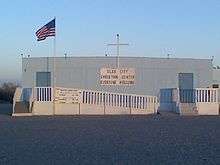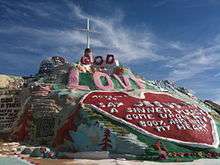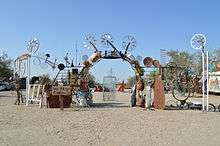Slab City, California
| Slab City | |
|---|---|
 Slab City | |
| Location | Sonoran Desert, California (4 miles northeast of Niland, CA) |
| Coordinates | 33°15′32″N 115°27′59″W / 33.25889°N 115.46639°WCoordinates: 33°15′32″N 115°27′59″W / 33.25889°N 115.46639°W |
| Website |
web |
Slab City or The Slabs is largely a snowbird community in the Sonoran Desert located in Imperial County, CA 156 miles northeast of San Diego within the California Badlands, and used by recreational vehicle owners and squatters from across North America.[1][2] It took its name from concrete slabs that remained from the abandoned World War II Marine Corps barracks of Camp Dunlap.
Several thousand campers, many of them retired, use the site during the winter months. The "snowbirds" stay only for the winter before migrating north in spring to cooler climates. The temperatures during summer are unforgiving [as high as 120 °F (48 °C)]; nonetheless, there is a group of around 150 permanent residents who live in "The Slabs" year round. Some of these "Slabbers" derive their living from government programs and have been driven to "The Slabs" by poverty. Others have moved to "The Slabs" to learn how to live off the grid and be left alone. Still others have moved there to stretch their retirement income.
The site is both decommissioned and uncontrolled, and there is no charge for parking. The site has no official electricity, running water, sewers, toilets or trash pickup service. Many residents use generators or solar panels to generate electricity. Supplies can be purchased in nearby Niland, CA located about four miles (6 km) southwest of Slab City.
History

1942: Construction of Camp Dunlap
Camp Dunlap, in which "The Slabs" now sits,[3] was expected to prepare the United States Marine Corps for combat duty.
1949: Military operations reduced
Military operations at Camp Dunlap had been greatly reduced, but a skeleton crew continued until the base was dismantled.
1956: Camp Dunlap dismantled
All buildings were ordered to be dismantled; the slabs remained.
1961: Land conveyed to the State of California
As of October 6, 1961, a quitclaim deed conveying the land to the State of California was issued by the Department of Defense as it was determined the land was no longer required. The deed did not contain any restrictions, recapture clauses or restoration provisions. All of the former Camp Dunlap buildings had been removed. The remaining slabs were not proposed for removal. Later, legislation required that revenue generated from this property go to the California State Teachers Retirement System.
Creosote harvesting
At some point, a chemical company in Oakland, CA hired 20 men to harvest creosote leaves near Niland, CA. Some workers moved closer to work by living in small trailers at the abandoned Camp Dunlap. This was the start of what is now called Slab City.
1965 migration to Slab City began
Riverside County, CA ordered people to leave a camping area at Painted Canyon near Mecca, CA. These people had all sorts of living arrangements; besides trailers, there were cardboard and plywood shacks, and a variety of vehicles and school buses. Some migrated to what is now Bombay Beach Georgetown, south of the Fountain of Youth, and the abandoned Marine Training Base Camp Dunlap now known as Slab City.
Attractions
Salvation Mountain

Located just east of California State Route 111, the entrance to Slab City is easily recognized by the colorful Salvation Mountain, which is a small hill approximately three stories and entirely covered in acrylic paint, concrete and adobe, and festooned with bible verses. It was a project over two decades by Leonard Knight.[4]
East Jesus

East Jesus is an experimental, sustainable and habitable art installation located in the Slab City area. There is no religious connotation in the name East Jesus – it is a colloquialism for a place in the middle of nowhere beyond the edge of service availability; the off-grid facility operates with no municipal utilities.[5] In early 2007, Charlie Russell left his job in the technology industry, packed all his belongings into a shipping container and sent it to a trash-strewn field where he began to surround his two art cars with sculptures that would become the foundation works of East Jesus. The Chasterus Foundation, a 501(c)3 non-profit formed after his death in 2011, has since guided the curation and expansion of East Jesus.

Made from discarded material that has been reused, recycled or repurposed, East Jesus encourages visitors to imagine a world without waste, in which every action is opportunity for self-expression. Assemblage and mixed-media art cover nearly every inch of it, interior and exterior. Sculptures and installations are constantly in development throughout campus, and the musical performance space holds a PA and stage lighting system, and studio grand piano.[6] There are also a solar power system, full kitchen and battery bank made up of expired batteries disposed by telecom companies.[7] Photography, multimedia art, performance art, writing and music are integral parts of a larger fabric, which their artists collectively are continually weaving. East Jesus artwork is living, growing and ever-changing, and embraces the thousands of varied voices from contributing artists who have added to the installation. Each day, residential staff gives dozens of free tours, and hosts visiting artists and overnight guests.[8]
The Range
The Range is an open-air nightclub complete with stage, lights, amplifiers, speakers with tattered couches and old chairs for seating. Every Saturday night at around dusk, locals and visitors meet for a talent show that features permanent resident musicians and anyone else who wants to get up on stage and perform. The venue is run by an old-time resident of 14 years named Builder Bill.
In popular culture
Films
- Slab City was one of the settings featured in the Sean Penn film Into the Wild (2007) based on Jon Krakauer's eponymous 1996 book that recounted Christopher McCandless' adventure across North America culminating in his death in the Alaskan wilderness. In the book and movie, McCandless spent time with itinerant residents of Slab City named Jan and Rainey, and struck up a relationship with a teenage girl named Tracy.
- Below Sea Level (2008), a multiple award-winning documentary by Italian director Gianfranco Rosi, was filmed in Slab City. The film was shot over a five-year period and documented the lives of a small group of otherwise homeless residents living in RV's, buses, tents etc.[9]
- It is visited in the BBC made-for-TV documentary film American Nomads (November 28, 2011).[10]
- Vice created a YouTube video featuring Slab City called Living Without Laws: Slab City, USA (May 15, 2012). The synopsis read: "This bizarre, lawless land in the California desert is inhabited by drug addicts, eccentrics, army veterans, hippies and just plain old weirdos. Slab City is referred to by its residents as "the last free place in America."" )[11]
Games
- A parody of the city called Stab City is featured in video game Grand Theft Auto V (2013). It is portrayed as a run-down trailer park filled with a gang of bikers.
Literature
- Slab City was featured in Sue Grafton's detective novel "G" Is for Gumshoe (1990), in which a missing person was last seen at her residence at Slab City.
- Slab City was also talked about in an article from various Uncle John's Bathroom Reader books.
Radio
- Slab City was featured in an episode of NPR documentary program Hearing Voices called "Small Town" the week of November 11, 2009. The segment's synopsis read: "This town in California never did exist, though it's full of folk who live there: an unofficial RV Park and home to the homeless thrives in culture and community."[12]
Webisodes
- Slab City was highlighted in "The Last Free City in America" (September 1, 2015), a Season 8 episode of Youtube comedy series Good Mythical Morning.[13]
See also
References
- ↑ Perry, Tony (December 18, 2011). "Slab City, a trailer park utopia, thrives in remote desert". Los Angeles Times. Retrieved 2015-03-25.
- ↑ Motlagh, Jason (February 3, 2012). "Slab City, Here We Come: Living Life Off the Grid in California's Badlands". Time. Retrieved 2015-04-20.
- ↑ Punctuation
- ↑ Leonard Knight passed away on February 10, 2014 in El Cajon, CA following a long illness.
- ↑ Yuki Toy. "ロサンゼルスから東へ320km 砂漠の共同生活地区「イーストジーザス」に住む漂流者たちの生活に潜入レポート – 自由って何?". ロサンゼルス発 ジャパラマガジン®.
- ↑ Johnson, Robert (November 21, 2014). "13 Rules for Surviving the East Jesus Artist Community". Pixable. Retrieved 2015-04-20.
- ↑ "6 Reasons You're Picturing the Post-Apocalypse Wrong". Cracked.com. Retrieved 2015-11-11.
- ↑ Bastow, Clem (September 25, 2014). "Here's What It's Like to Live in a Sustainable Art Installation That's Being Slowly Swallowed by the Desert". Junkee. Retrieved 2015-04-20.
- ↑ Gianfranco Rosi (Director) (2008). Below Sea Level. Slab City, California.
- ↑ American Nomads. BBC. November 28, 2011.
- ↑ Quintero, Ernie. Living Without Laws: Slab City, USA. Vice Magazine.
- ↑ "HV076 - Small Town: HearVox". hearingvoices.com. Retrieved 2010-11-19.
- ↑ "The Last Free City in America". Good Mythical Morning. YouTube. September 1, 2015.
External links
| Wikimedia Commons has media related to Slab City, California. |
| Wikivoyage has a travel guide for Niland. |
- East Jesus
- Salvation Mountain
- Slab City and East Jesus on Abandoned USA
- Tioga George's "Vagabonders" webpage
- Slab City footage and interviews by Sherman George and Greg Durbin, University of California in San Diego Library Digital Collections
- Slab City Stories
- Down and Out Escape to 'Slab' in California Desert, NPR Around the Nation, January 24, 2012
- 2012 Time Magazine article.
- 2004 New York Times article, login may be required.
- 2003 UK Guardian article.
- Howser, Huell (January 8, 1997). "Slab City (806)". California's Gold. Chapman University Huell Howser Archives.
Template:Imperial County, CA